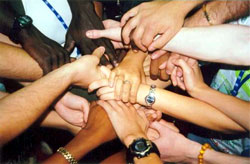This is the third published article of a series on intercultural learning by Lene Mogensen from The Sparkle. Read the first and the second article.
During my previous articles on this page I have raised critique against intercultural learning (ICL) as used in European youth work these days. I have described how some intercultural learning exercises like the Derdians, where participants are split into those that have modern knowledge and those that have traditional culture, present an old-fashioned understanding of culture, leading to the risk of creating prejudices through intercultural learning.
It might now be time for a small disclaimer — or as we would say in Danish (according to an old aphorism), we have to watch out that we do not “throw out the baby with the bathwater”. Intercultural learning focusing on creating awareness of cultural differences can be useful… in certain situations at least.

Many exercises that are prevalent in current European youth work are based on work done within the business sector. The business sector has developed training programmes, which aim at making business men or diplomats aware of cultural differences in other countries, when they take an overseas assignment or have to negotiate with businesses from other countries.
If one single person is going to travel to another (culturally very different) country, there is indeed a big chance that the persons he will encounter with, will on average be “culturally different” than him, and he does well in adapting his communication style accordingly if he wants a successful outcome for himself and the company.
This approach adapted to youth work makes sense when it comes to preparing individuals for a long term exchange programme like European Voluntary Service (EVS) projects of the YOUTH programme. Or when it comes to developing projects with organisations from diverse countries that have to reach a common agreement.
However, the same ICL approach is used during trainings focusing on societal changes – on involving ethnic minorities in youth work, on fostering diversity, fighting xenophobia, racism and intolerance etc. The argument goes that because it all has to do with culture the answer is the same: increase the contact between culturally diverse people, make them aware of cultural differences, and voila… you get tolerance, acceptance etc!
Practice seems to be based on the “contact hypothesis” that came into fashion in the 50’s stating that increased contact would automatically diminish prejudices – unless the contact was superficial. So one of the objectives of many short-term exchanges, seminars and trainings is to get a group of people together from as many nations as possible (both in the team as in the group of participants) — the greater the geographical spread the better.
But isn’t getting a group of young people from different cultures together for one week exactly that: superficial? Add to this that the research never has been able to confirm the hypothesis about increased contact leading to increased tolerance. The human being is a group-animal; we tend to identify with our in-group and see “the other group(s)” as less good — whether we talk about cultural groups, youth groups and organisations, social class etc. Bringing representatives from such groups together does not a priori tear down the boundaries, but might just as well lead to increased conflicts and prejudices if there is no common goal for the different groups.

Okay you might think — but that is why we do not just bring them together but also try to stimulate intercultural awareness, give people knowledge about cultural differences etc. But to this I have to add that learning that a Turkish immigrant behaves in the Turkish way is not actually telling me anything about his experiences as an immigrant, but giving me some stereotypes about this person.
Can a participant from Turkey really teach us about the lived experience of a 3rd generation minority whose grandparents originally emigrated from Turkey and now live in Denmark? (Would we ever dare to ask the granddad of young Danish woman, what her culture is and how her behaviour should be?).

Stereotypes is to judge people according to their group-belonging, thinking that somebody behaves like everybody else from that group and has no will of his or her own. It doesn’t tell me anything about this person’s dreams for his own life, about his visions for the society he lives in and about the possible discrimination he might have experienced. Moreover as discussed in previous articles the challenges of multiculturalism in our societies is not just about culture — it is about power, social inequality, access to education, proper housing, job-market and decision making bodies. Focusing on culture disempower us by hiding these other factors.
There are at least two big differences between the two mentioned situations: On the one hand travelling abroad or starting cross-national cooperation, and on the other hand dealing with challenges of multicultural societies:
First of all the first kind of situations justify that I assume that the people I am going to deal with in the foreign culture are averagely “culturally different�? from me. However, assuming this in a multicultural society, means judging the individual based on group belonging – it means robbing immigrant youth from defining their own life rather than live the ones of their parents and grandparents, and it means making culture the major determinant of their behaviour.
Secondly the first kind of situations imply a common goal: we are going to cooperate in the same business, organisation or network and have to negotiate a solution we can all agree upon. The situation of multicultural societies is different: Majority and minority often compete about the same resources: the same apartments, the same jobs, the same political positions. Not surprisingly racism and xenophobia is most prevalent in the lowest classes — among the people who are afraid of losing the most in this fight. And those in power do not necessary have a wish to truly include minorities as this might endanger their positions as well.
So what should be the outcome of intercultural learning? I would claim that this depends on which situation you are going to deal with: preparing individuals or teams for time-limited travel or co-operation or work towards increased tolerance and inclusion in multicultural societies. Just being aware of cultural differences is not good enough, but the participants need specific competences to deal with the different situations.
Therefore specific training approaches need to be developed for each situation instead of just using the same simulation exercise in all cases.
Lene Overgaard Mogensen, The Sparkle (lene@thesparkle.org)
Fire away with your comments!
Comments
2 responses to “Intercultural learning”
Lene, thanks for another inspiring and informative read! Just a little extra information for interested readers:
The inter-group contact theory was described by Gordon Allport in 1954 in his book “The Nature of Prejudice”.
According to Allport, intergroup contact would lead to reduced intergroup prejudice if the contact situation embodies four conditions: 1) equal status between the groups in the situation; 2) common goals; 3) no competition between the groups; and 4) authority sanction for the contact. (Source)
Also, Pettigrew and Tropp have conducted substantial research in the area and claim in a recent paper that “considerable research has shown that greater intergroup contact corresponds with lower intergroup prejudice.”
Source: Pettigrew & Tropp (2005).
Hallo to all,
I am not sure if at this time of my day I can write something coherent in response to all inspiring and enriching things that I read above, but at least I’ll do my best to put down some bits and pieces of my brain’s production.
Above all, thank to Lene for the “thought motivators” articles and Andreas for his overall work in this space.
On the article:
“Therefore specific training approaches need to be developed for each situation instead of just using the same simulation exercise in all cases.”
Totally agree. I would also put it like this “using the same simulation exercise over over, whether you deal with ICL within a short term international activity or with developing respect and understanding within multicultural societies, will not be of any value if we don’t somehow incorporate in its execution/evolution, elements related to the particular group, the dynamic, the environment, the level and so on, that will set the exercise as relevant, context-sensitive and effective for the specific situation”. Which in other words is “keep the basis – once you are experienced in it – and build up the experience synthesizing the nearby reality”. Concluding; the facilitator has the major role in this process. But unfortunately, even the 231 youth trainers (as searched on SALTO 27/2/07) that can implement intercultural learning as an educational approach within international youth activities, are not enough (as a number…it’s not the time to write on sufficiency of competences) to respond (and when responding, to respond efficiently) to the hundreds of “developing respect to diversity” activities taking place every year in European level.
“Just being aware of cultural differences is not good enough, but the participants need specific competences to deal with the different situations.”
Can’t agree more. “Being aware” is at least one step ahead of “having heard” or “my friend/the TV said”…Awareness takes at least some moments of personal involvement and it also makes use of the mind; at least a bit more than just simulating the auditory nerve, to put it this way. So, Lene said it nicely “not good enough”…Which is good but not enough…It has not been scientifically researched, but what I am personally feeling when interacting with some hundreds of young people that I have “sent abroad” (sounds simplistic, but it can be used as a common criterion) is that, in general, every next encounter among them and “people, on average, culturally different” is not the same as the previous one; I dare to say that, at least, they are more curious; and these cases are maybe of the very few that the cat is not killed…
And something about superficiality; it sounds like a qualitative term to me.
There can be a groups’ contact for some months/years and still ranked as superficial. Just because the “ground is not fertile” (as in the majority/minority case shortly described above in Lene’s article).
Some “culturally different” people might spend a couple of hours reflecting in common on the ICL activities of the day and discussing about life and everything and their intercultural sensitivity to grow in disproportion to the time spent. For me it is again a matter of the “facilitators”; but this time I use the term more widely; it can be the trainers, the environment, the overall stimuli sprung from the educational activity, the program itself, the people around and so on…The major figure/s (the person/s’ actions that will reduce superficiality)is the one/ones who – to put it in general – have perfectly described ICL in their application for funding and the ones that are entitled to implement what has been described.
It’s also interesting to say that for instance, in a youth exchange, ideally 1) there is equality in status, 2) common goals set, 3) no competition among groups 4) an authority has sanctioned the contact (but this one don’t know how important is, maybe because I can not understand it sufficiently). There you go…
It took more than I expected so I can only hope that it is easy to be read.
Thank you again for the space and time.
Sakis